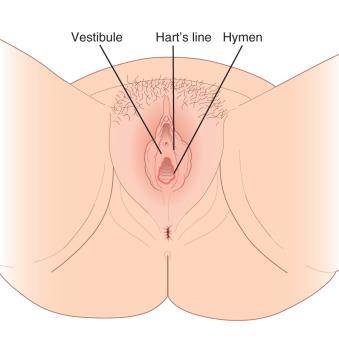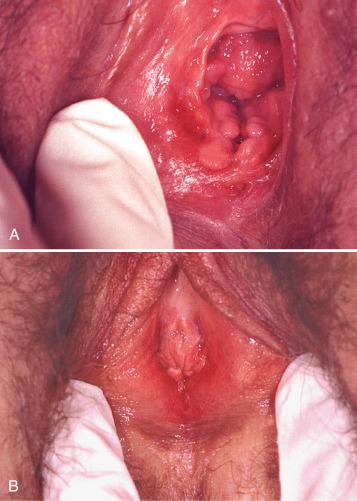Physical Address
304 North Cardinal St.
Dorchester Center, MA 02124
Vulvodynia is defined as a chronic discomfort or pain, consisting of burning, stinging, irritation, and rawness on the vulva. It was once believed to be a rare condition, but is now known to affect millions of women. It can be a chronic pain disorder, at times associated with other chronic comorbid pain conditions. The prevalence of vulvodynia is 8.3%. The prevalence remains stable through age 70 years and has been shown to decline thereafter. The pain can be generalized—diffuse vulvar burning or irritation—or localized—pain at a specific area, such as the vestibule or clitoris. Localized vulvodynia that was previously termed vulvar vestibulitis is currently termed vestibulodynia . The vestibule is defined as the area between the hymen and Hart's line ( Fig. 3.1 ).

Vulvar pain discussion first appeared in the literature in 1861 in an article by Sims. He described a patient he saw in 1857 with vaginismus, but on further analysis of her history, she appeared to have vulvodynia. Thomas has described the condition as “excessive hypersensibility of the nerves supplying the mucous membrane of some portion of the vulva.” In 1889, Skene depicted a condition “characterized by a supersensitiveness of the vulva. … When, however, the examining finger comes in contact with the hyperaesthetic part, the patient complains of pain, which is sometimes so great as to cause her to cry out.” In the same year, Kellogg wrote about a patient with “sensitive points about the mouth of the vagina.” The topic was not readdressed until 1928, when Kelly saw a woman with “exquisitely sensitive deep red spots” that were a “fruitful source of dyspareunia.” In 1983, Friedrich reported on 13 patients with “vestibular adenitis.” Terminology has continued to change with time. The International Society for the Study of Vulvovaginal Disease (ISSVD) popularized a definition of vulvar pain in the 1980s (essential or dysesthetic vulvodynia), describing patients with a chronic discomfort and burning, stinging, irritation, and rawness of the vulva. In 1987, Friedrich proposed the term vulvar vestibulitis syndrome . There are two major forms of vulvar pain: hyperalgesia (low pain threshold) and allodynia (pain to light touch). The terminology of pain localized to the vulvar vestibule continues to undergo changes. Table 3.1 demonstrates the changes in terminology for vulvar pain that have occurred with time, up to the 2003 terminology. Concerns with the terminology were present. Recently, a new vulvodynia terminology has been approved ( Box 3.1 ).
| Vulvar Dysesthesia (1999) | Vulvar Dysesthesia (2001) | Vulvodynia (2003) |
|---|---|---|
| New Mexico, United States, ISSVD World Congress | Lisbon, Portugal, ISSVD World Congress (N ote : This was a provisional terminology system.) |
Salvador, Brazil, ISSVD World Congress |
| Generalized vulvar dysesthesia | Provoked vulvar dysesthesia Generalized Localized (vestibule, clitoris, other) |
Vulvodynia, generalized Provoked (sexual, nonsexual, both) Unprovoked Mixed (provoked and unprovoked) |
| Localized vulvar dysesthesia Vestibulodynia (formerly vulvar vestibulitis) Clitorodynia Other localized forms of vulvar dysesthesia |
Spontaneous vulvar dysesthesia Generalized Localized (vestibule, clitoris, other) |
Vulvodynia, localized (vestibulodynia, clitorodynia, hemivulvodynia) Provoked (sexual, nonsexual, both) Unprovoked Mixed (provoked and unprovoked) |
Vulvar pain caused by a specific disorder a
a Women may have both a specific disorder (e.g., lichen sclerosus) and vulvodynia.
Infectious (e.g., recurrent candidiasis, herpes)
Inflammatory (e.g., lichen sclerosus, lichen planus, disorders)
Neoplastic (e.g., Paget disease, squamous cell carcinoma)
Neurologic (e.g., postherpetic neuralgia, nerve compression or injury, neuroma)
Trauma (e.g., female genital cutting, obstetric)
Iatrogenic (e.g., postoperative, chemotherapy, radiation)
Hormonal deficiencies (e.g., genitourinary syndrome of menopause [vulvovaginal atrophy], lactational amenorrhea)
Vulvodynia—vulvar pain of at least 3 months' duration, without clear identifiable cause, which may have potential associated factors
The following are the descriptors:
Localized (e.g., vestibulodynia, clitorodynia) or generalized or mixed (localized and generalized)
Provoked (e.g., insertional, contact), spontaneous, or mixed (provoked and spontaneous)
Onset (primary or secondary)
Temporal pattern (intermittent, persistent, constant, immediate, delayed)
IPPS, International Pelvic Pain Society; ISSWSH, The International Society for the Study of Women's Sexual Health
ISSVD, The International Society for the Study of Vulvovaginal Disease.
Patients with vulvar pain localized to the vestibule have a normal-appearing vulva, other than occasional erythema ( Fig. 3.2 ). The erythema tends to be most prominent at the Bartholin's, Skene's, and vestibular duct openings. The other form of localized pain is clitorodynia. Pain associated with an abnormal vulvar appearance does not qualify for the diagnosis of localized vulvodynia ( Box 3.2 ).

Podophyllin overdose
Condylox (podofilox) overdose
Behçet disease
Aphthous ulcers
Herpes (simplex and zoster)
Candidiasis
Trichomonas
Chancroid
Sjögren disease
Contact dermatitis
Endometriosis
Pemphigus
Pemphigoid
Atrophy
Lichen sclerosus
Lichen planus
Crohn disease
Bartholin's abscess
Trauma
Imperforate hymen
Prolapsed urethra
Vulvar intraepithelial neoplasia
Carcinoma
Many theories have been proposed for the causes of vulvodynia, including abnormalities of embryologic development, infection, inflammation, genetics, immune factors, nerve sensitization, and increased muscle tone. The exact cause of vulvodynia is unknown; there likely is no single cause.
McCormack and Fitzpatrick et al. have linked vestibular pain with interstitial cystitis, another idiopathic inflammatory syndrome of the urogenital tract. They have speculated that the tissues from two distinct anatomic sites have a common embryologic origin and therefore are predisposed to similar pathologic responses when challenged. Additional studies have found an association between vulvodynia and interstitial cystitis.
Become a Clinical Tree membership for Full access and enjoy Unlimited articles
If you are a member. Log in here